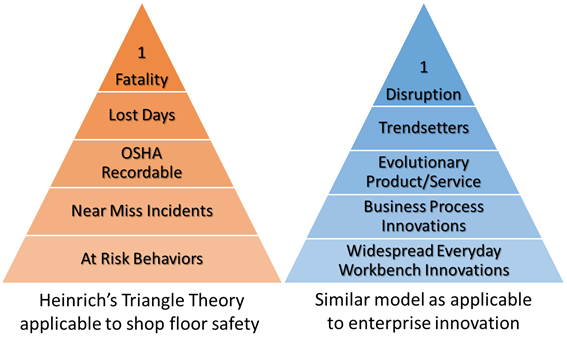Why everyday workbench innovations matter?
Really?
Safety and Innovations are both an outcome of mindset or a cultural issue. They both require constant situational awareness, creativity, ideation and risk reduction at operational level, and management commitment at the top levels. That mean Heinrich’s triangle for shop floor safety should also be applicable to enterprise innovation.

Corporate Innovation Triangle
Heinrich’s safety triangle model in a workplace states that for every accident that causes a major injury, there are 29 accidents that cause minor injuries and 300 accidents that cause no injuries. His theory, given in 1931, was an empirical finding based on actual data from the 1920s. Today the numbers may be different for different sectors, but the concept of the triangle or pyramid is still valid. Frank Bird’s analysis in 1966, based on over 1.7 million accident reports from over 300 companies depicted similarly, but with 600 incidents at the base and a single death at the top.
I believe the same triangle law applies to innovation. For us to get one disruptive innovation, we need to get a few breakthroughs and trendsetters, many evolutionary innovations, and a continuous improvement in business processes, all supported by widespread workbench innovation.
In some sense, companies like 3M and Google are where they are today because of this very fundamental cultural aspect. They encourage a widespread innovation mindset. Almost everybody is encouraged to engage in novel value creation most of the time. Multiple things go into building a mindset. It all begins with questioning the well-known wisdom around the business (status quo).
Strategy, roadmap, capital, tools, and processes discussed in the first three sessions are necessary, but not sufficient, to be a consistent innovator. Having the right mindset is what brings success.
Some workplaces respond to safety issues only there is an accident. Others build it into the mindset through everyday discussions. During my corporate career, we used to have “Safety Minute” which was a one-minute discussion in every staff meeting around how an employee has improved safety in their workplace.
Some companies try to launch innovation projects when they are losing customers or falling short on deliverables. Others build it into the mindset through everyday discussions. I have successfully copied the safety concept to “Innovation Minute” which is a one-minute discussion in every staff meeting on what someone might have read about innovation outside of the company/industry and may have relevance to their workplace.
The ‘Innovation Triangle’ needs an innovation mindset at the bottom, like safety mindset in the industry built over the years. This requires some unlearning and reprogramming at the leadership level, which ignites creativity, encourages exploration, and accepts failure while exploring.
In Summary,
Just like cost of accident prevention is lot less than cost of serious injury or death. Cost of innovating is lot less than cost of not innovating. We all talk about ROI. We rarely talk CONI “Cost of Not Investing”. How much will it cost you, if a competitor launches a product or service before you do and you are now forced to respond, rather than forcing your competitors to respond to your great ideas?
If you like this blog post, you will like my book “Inspiring Next Innovation Mindset” available on Amazon
If you wish to engage with me in a conversation on innovation mindset, please register for online session scheduled on April 01, 2021 from 9:00 AM to 10:00 AM ET (-4:00 UTC) co-hosted by Nerac.
